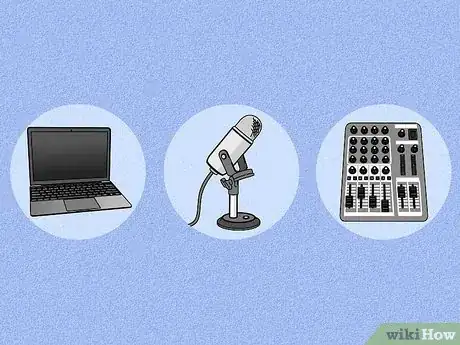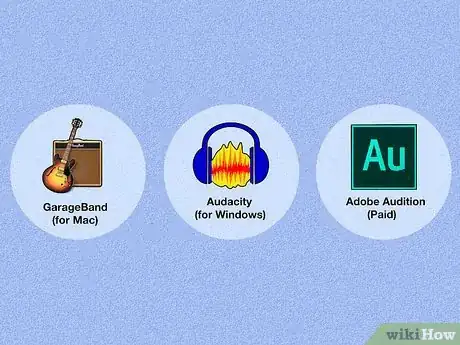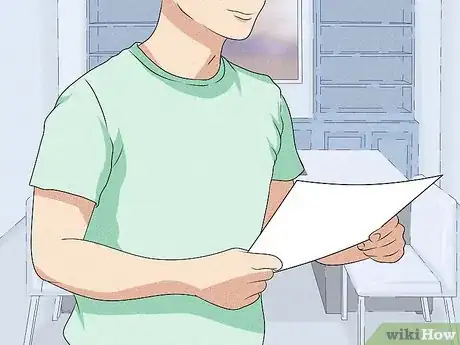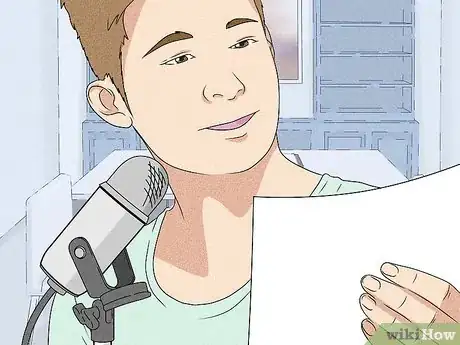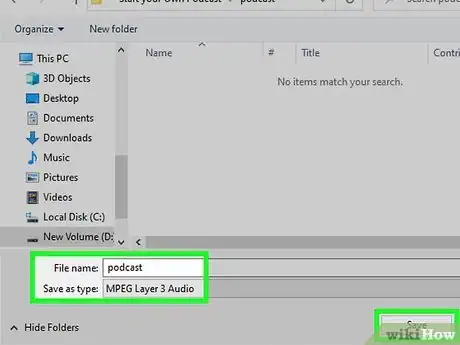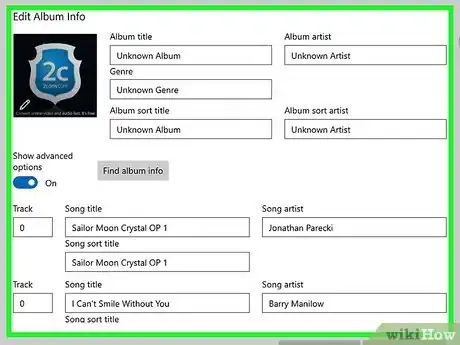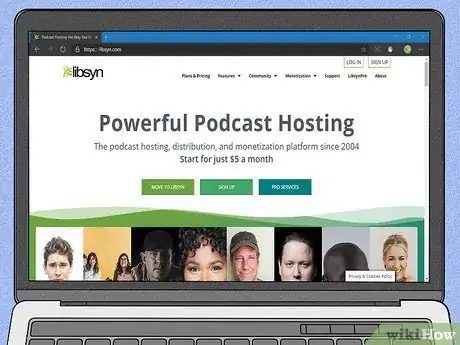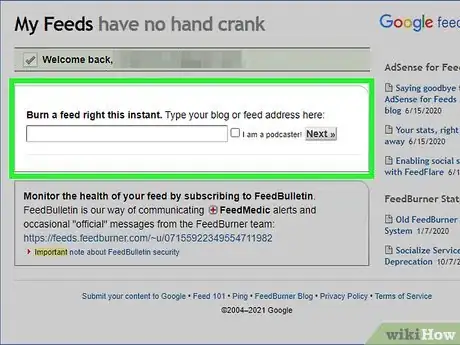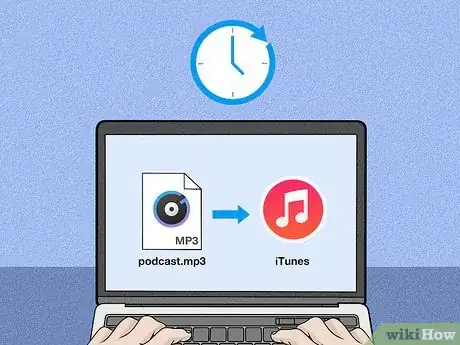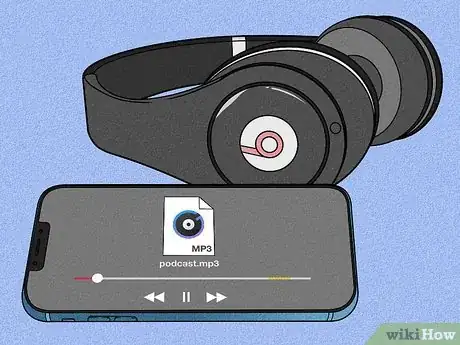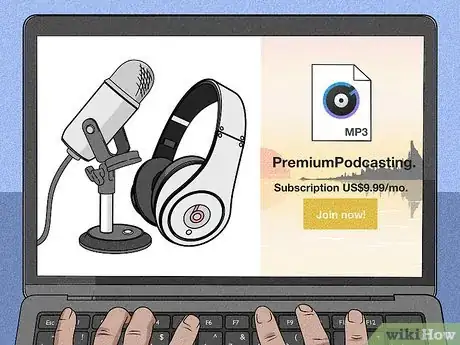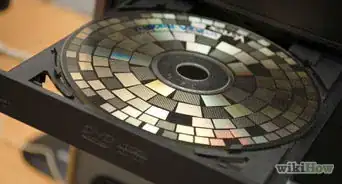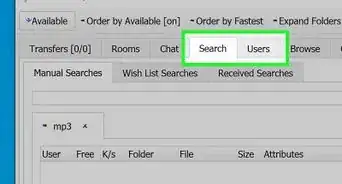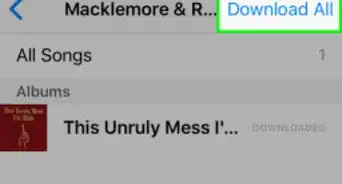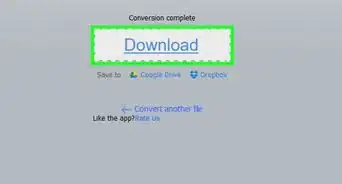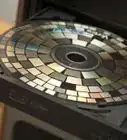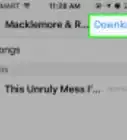This article was co-authored by David A. Payne, JD. David A. Payne is the President and Executive Producer of RainStream Media, a media company who focuses on telling true crime stories with underlying themes of social justice. He has extensive experience in media and entertainment, having served as both General Counsel and a C-level executive for comapnies such as Turner Broadcasting, CNN, and USA Today. He is also a lawyer - he received his JD from the Duke University School of Law and is licensed to practice law in California.
This article has been viewed 1,282,870 times.
Creating, promoting, and distributing your podcast to reach an online audience of possibly millions is relatively easy. Podcasting is becoming more popular as many bloggers turn to Internet radio shows to get their music/message out. You can get your podcast online in just 5-10 minutes! All you need is yourself, some recording equipment, Internet access, and an interesting topic to talk about!
Steps
Before Recording
-
1Determine the nature of your podcast. What will the content be? Write it down so you don't forget. Come up with an outline or some sort of organizer to keep track of what you will discuss and/or promote.
- There are countless examples among the podcasts already in existence. Podcasts.com lists podcasts by categories, which include comedy, news, health, sports, music and politics. Some examples include Mugglecast, which covers "Harry Potter" novels and films; The Word Nerds, who discuss the etymologies of words and other linguistic matters; Fantasy Football Minute, a podcast to help all fantasy football coaches and general managers; and NPR Science Friday, a podcast version of the weekly show broadcast on local public radio affiliates, just to get your mind rolling.[1]
- Listen to some of the more popular podcasts to get a feel for style and content. Draft up an outline to keep the awkward pauses at a minimum. If you're going to be doing interviews with your pets, this will be something you probably want scripted.[2]
-
2Choose the products you'll use to Podcast. Most podcasts include a microphone (USB or analog), mixer (for analog mic) or even a new computer. There are different podcast starter packages out there you can buy for around $100.
- Don't rely on the standard (and iffy at best) microphone your PC came with if you want to sound as professional as possible. You'll want a full headset with a noise-canceling mic to be positive your listeners aren't getting distracted by the sound of your air conditioner in the corner.[2] For affordable voice recording, a unidirectional, dynamic-type microphone is good. Radioshack sells inexpensive ones and you’ll also find a good selection of higher quality mikes at most music stores.
- Is your podcast going to be portable or will you record at home? Maybe you want to podcast using your smartphone or tablet (Android, iOS). But the basics you'll need are a microphone and voice recording podcast software. You'll only need a mixer if you have multiple inputs. Smaller units with around four inputs will suit all but the most ambitious podcasts.
Advertisement -
3Pick your software. If you have a Mac, you can record using Garageband (it comes free with every Mac as part of the iLife suite). There are free software packages (like Audacity) and expensive software (Adobe Audition). There are also tiered versions of software, like Sony Acid (music studio is only $50 whereas Acid Pro is $200). Some mixers and microphones come with free software to use.
- Industrial Audio Software's aptly named iPodcast Producer is super podcast friendly. It takes care of the whole process from recording to uploading the finished product via a built-in FTP client. However, it's just about the opposite of free.[2]
- Audacity (is free!) has an easy learning curve and there are Windows, Mac, and Linux versions available. It has a number of useful features and plug-ins.[3]
- If this is more than you bargained for, Sound Recorder (on Windows) does everything you need it to do, but only saves files in .wav format; you will still have to convert your final recording into an .mp3 file. MusicMatch Jukebox can also do this for you.
- If you go with Adobe Audition, you can get a monthly subscription through the Adobe Cloud that offers the entire Adobe site (with lower costs for students). Additionally, Lynda.com has an excellent video tutorial (about 5 hours or so worth) on everything Adobe (and lots of other technologies, too) that you can access with a month to month subscription that you can terminate at anytime.
Creating Your Podcast
-
1Prepare your content. You may want to put together scripts for what you will say at the beginning of a show and when you transition from one story to another. Put your content in order so you can read down the list.
- Whatever it is, make sure you enjoy it. You probably won't become rich from this endeavor. Spend your time discussing or promoting something you really care about; the reward will be in feeding your knowledge/humor/music to others.
-
2Record the audio for your podcast. This is probably the biggest step for without your voice, your podcast doesn't exist. Talk in a consistent pace and show passion in your subjects. Read the scripts and don't forget to thank people for being part of the show.
- You can have the perfect podcast delivered, but sometimes technical glitches run the show, ruining all your hard work. Before you begin the actual recording session, take a few samples to test the software, mess with the volume controls, and just plain make sure everything is functioning.[2]
-
3Save the audio file to your computer desktop. Make sure it's in MP3 format; a bit rate of 128 kbps is probably sufficient for a talk-show podcast, but podcasts featuring music will want bit rates of 192 kbps or better.[1]
- Do not use special characters (such as # or % or ?) in the file name. Open it up into your sound editor and edit out extra background noise or long periods of silence. Put in intro/outro music if you'd like.
- Of course, you can always save it as a WAV file first, to give you a master backup to work from if something were to go wrong.
-
4Tag it, give it ID information (artist, album, etc.) and give it album art. Either make it yourself, find some free, non-copyrighted images online, or have a friend make one for you.
- Be careful to name the audio file so that the name of the podcast and the date of the episode are clear. You may also want to edit the ID3 tags of the MP3 file to help people find and catalogue your podcasts.
-
5Create your RSS podcast feed. The feed must meet all industry standards for a valid 2.0 feed with enclosures. Try using a complete solution and service such as Libsyn, Castmate or Podomatic (see the external links below). For longer podcasts, you'll be paying a small fee.
- The easiest way to do it is to use a blog. So hop on over to Blogger.com, Wordpress.com, or another blogging service, and start a blog with the title of your podcast. Don't make any posts just yet.
- If your host has limits on the amount of bandwidth you can use, you could incur overage charges if your podcast becomes very popular (fingers crossed!).
- A feed acts like a "container" for the MP3 file that tells feed aggregator programs where to get new episodes. It can be done manually with some XML coding. It's similar to HTML. You can copy another RSS file and use the template to make your necessary modifications.
- The easiest way to do it is to use a blog. So hop on over to Blogger.com, Wordpress.com, or another blogging service, and start a blog with the title of your podcast. Don't make any posts just yet.
Uploading Your Podcast
-
1Put your RSS podcast feed on the Internet. Go to Feedburner and type in the URL of your blog and click "I am a podcaster!" In the next screen, configure the elements for your podcast. These are the elements that directly relate to the podcast. Your feedburner feed is your podcast.
- Go to one of the hosts you can find online and sign-up there (this may take a while). Then go to your files, and upload your MP3 file.
- Make a post on your blog/website -- the title of the post should be the title of that episode of the podcast, and the content will end up as the "Show notes" or the "Description." Put in a little about what you talk about in your episode. At the end of the post, put a link directly to your media file.
-
2Give it a second. In a few minutes, Feedburner should add this to your feed, and now you have an episode! You can submit it to iTunes or a number of other podcast directories to get it known. You may want to wait, however, until you have some experience, so that your podcast will be compared as a fifth episode to another's first.
- Submitting a podcast to iTunes is fairly simple. The podcast page in the iTunes store has a large button that asks for the RSS link and some additional information about the podcast. A podcast can also be submitted via the Web through the link in the iTunes FAQ.[1]
- Ping the appropriate podcast directories when a new show is updated.
- Put the appropriate subscription buttons on your website so people can subscribe to the RSS podcast feed.
Making Money from Your Podcast
-
1Sell the podcast. You can set up a Web store to charge subscribers for each episode. However, a pay-per-listen podcast is competing with thousands of free podcasts. The content would have to be very compelling to convince very many people to shell out cash, so very few podcasts profit with this method.[1]
- In case you were thinking it, podcasts cannot be sold in the iTunes store.
-
2Sell advertising. If you insert a commercial into your podcast, listeners can easily skip over the ad when playing back the show on their computers or MP3 players. One option is to get sponsorship for the podcast, or even separate segments of the podcast. You may need to change the title of your podcast to allow the sponsor their due.
- Be sure you're not bombarding the listener with commercial after commercial. If your podcast is relatively short, a listener isn't going to want to hear three commercials in that small time frame. Especially at the beginning.
-
3Get into web advertising. This requires extra effort, because once someone subscribes to a podcast, it is downloaded directly into their RSS reader. They might never see the website again. The key is to tie the podcast into a blog or website and mention it frequently during the show. This will drive click traffic to the site and hopefully create some advertising revenue.[1]
- Think about banner and sidebar ads. The latter has a bit more impact because it's longer and you can't scroll away from it. As a result, it has a higher click-through rate.[4]
Community Q&A
-
QuestionHow much will it cost to start my own podcast?
 Community AnswerIt entirely depends on the nature of your podcast. If you want to start a podcast for your business, then it's going to cost you more. In case of a simple podcast, you might want to spend some money to buy a microphone of good quality and software to edit your podcast, which is optional.
Community AnswerIt entirely depends on the nature of your podcast. If you want to start a podcast for your business, then it's going to cost you more. In case of a simple podcast, you might want to spend some money to buy a microphone of good quality and software to edit your podcast, which is optional. -
QuestionWhere is the best place to post my podcast?
 Community AnswerYou could use a site like Soundcloud with an established listening audience; it might increase your chances of finding fans. If your podcast is specialized or focused on a particular topic, you could also post a link to your podcast on relevant sites or forums.
Community AnswerYou could use a site like Soundcloud with an established listening audience; it might increase your chances of finding fans. If your podcast is specialized or focused on a particular topic, you could also post a link to your podcast on relevant sites or forums. -
QuestionHow can I start a podcast with a person who lives far away?
 Community AnswerYou can really record a podcast using a video messaging program, such as Skype. It just involves a few simple steps and it's very easy to record.
Community AnswerYou can really record a podcast using a video messaging program, such as Skype. It just involves a few simple steps and it's very easy to record.
Warnings
- The bandwidth consumption can be astronomical. Make sure your podcast is hosted with a reliable server that can handle huge bandwidth spikes. Most cheap hosting services will not work for this.⧼thumbs_response⧽
- People won't want to listen to boring, run-on podcasts, or podcasts that don't have anything interesting enough each show, so vary and edit your material.⧼thumbs_response⧽
- Some podcasters delete episodes older than a certain length of time. People who have subscribed will still have the old episodes, but newer subscribers will only get the current ones. You may want to consider this.⧼thumbs_response⧽
- Make sure the RSS podcast feed is valid -- especially if you wrote it yourself. Go to http://rss.scripting.com/ and type in the address of where you uploaded your RSS file; it'll let you know if it's valid.⧼thumbs_response⧽
Things You'll Need
- Microphone
- Audio recording software
- Podcast Manager & Hosting
- A computer and mixer (if using multiple inputs)
- A webcam/camcorder (if video podcasting)
References
About This Article
If you want to start your own podcast, decide what kind of content you'll be covering, such as true crime, health, news, or conspiracy theories. Next, get the equipment you need to record, like a USB microphone and recording software, such as Garageband or Audacity. Then, put together your voice scripts, record the audio with your mic and software, and edit the recording until you're happy with the way it sounds. Finally, save the finished podcast as a single mp3 file and upload it to the platform of your choice. For tips on promoting your podcasts, read on!

